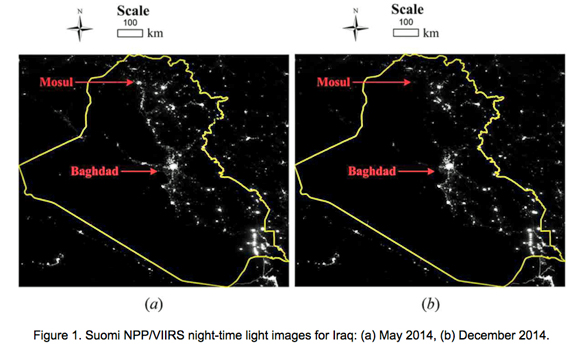[SatNews] The territory controlled by the Islamic State of Iraq and Syria (ISIS) has grown rapidly since the start of the Syrian Civil War, and in 2014, ISIS expanded its control into Northern Iraq.
While there are many media reports on violence and geopolitical issues surrounding the takeover of these areas, the impact on everyday life, such as access to electricity for people living in ISIS-controlled regions, is less clear.

In their recent study published in International Journal of Remote Sensing, Dr. Xi Li and Prof. Deren Li (Wuhan University, China) and Dr. Rui Zhang and Prof. Chengquan Huang (University of Maryland, USA) analyzed city lights as a proxy for the power supply in ISIS-controlled regions between May 2014 and December 2014. The city light data were acquired from the Visible Infrared Imaging Radiometer Suite (VIIRS) sensor on the NASA/NOAA Suomi National Polar-orbiting Partnership (NPP) satellite.
The analysis indicates that most of the ISIS-controlled cities, including Mosul and Tikrit, experienced a decrease of more than 90 percent in city light after being seized by ISIS, while the loss of light in cities controlled by the Iraqi security forces (ISF) was very limited. However, the city lights in Ar Raqqa, Syria, ISIS’ de facto capital, did not show a decline after that region was seized by ISIS.
These comparisons suggest that the conflict in Northern Iraq has resulted in a major loss of electrical power supply within the Iraqi cities seized by ISIS, and that this loss is most likely due to lack of access to the Iraqi power grid, rather than a deliberate ISIS strategy of limiting night-time light.
The insurgency in Northern Iraq since 2014 has led to a severe humanitarian crisis. It is widely known that it is extremely dangerous to collect information from ISIS-controlled regions; therefore, the use of remotely sensed night-time light images such as these offer humanitarian agencies and NGOs a low-risk indicator of socioeconomic conditions in war-torn countries like Iraq.
The information for this story was garnered from the article—“Detecting 2014 Northern Iraq Insurgency using night-time light imagery”—by Xi Li, Rui Zhang, Chengquan Huang and Deren Li, International Journal of Remote Sensing, 2015, published by Taylor & Francis Group.
http://dx.doi.org/10.1080/01431161.2015.1059968


